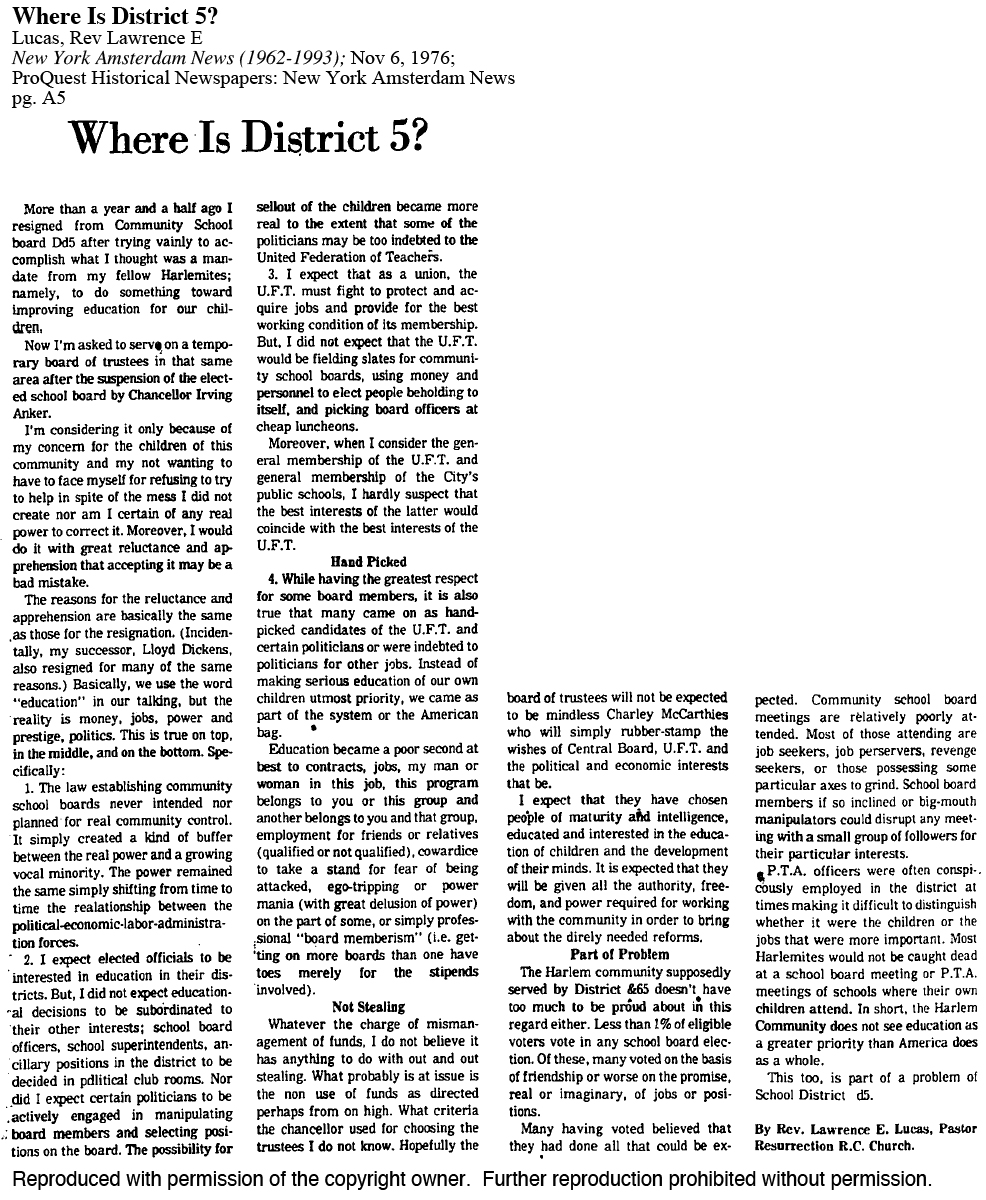Where is District 5?
Where is District 5?

Date: Nov 6, 1976
Caption: A Harlem minister explained his criticisms of his local school district.

Under decentralized school governance, each community school district had its own school board, and members of that board were elected by parents and voters who lived within the community school district’s boundaries. (It’s important to specify parents and voters because parents who were not citizens, and therefore could not vote in most elections, could vote in community school board elections where their children attended school.)
There were 32 community school districts. The Bronx, for example, was divided into 6 school districts. All of Staten Island remained one district, Community School District 31. Community school district enrollments ranged from roughly 15,000 to 35,000 students, making them much larger than the average US school district, although each was only a small part of the nearly one million-student NYC public school system.1 Community School District 5 covered most of Central and West Harlem above 125th Street. It included the area that had been previously part of the community control district in East Harlem as well.
Harlem’s Community School District 5 struggled soon after its creation. One board member was convicted of illegal use of campaign funds in 1973. In 1976, the chancellor used his power to suspend the elected board members, after a few years of very high turnover in the superintendent job and other signs that the board was not functioning effectively.2
The problems in Community School District 5 were in some ways only a more extreme version of challenges that many decentralized school districts faced. Voter turnout was very low across the city, as Rev. Lucas notices here, and low turnout meant that small groups, including at times teachers and other people working in the schools, rather than the parents and community members that decentralization had wanted to empower, could influence elections. District 5 and others also had school board members accused of corruption, and in some cases, as in Community School District 12 in the Bronx, there was evidence to support these accusations. Rev. Lucas addresses some of those concerns in his letter. Yet there were also districts that created innovative and successful new programs, as in Community School District 7’s new bilingual education program, and the small elementary and middle schools of choice in District 4.3
-
National Center for Education Statistics, “Characteristics of the 100 Largest School Districts in the United States,” https://nces.ed.gov/pubs2001/100_largest/discussion.asp#sc. ↩︎
-
Les Mathews, “District 5 Parents End Sit In,” New York Amsterdam News, July 24, 1976. ↩︎
-
Heather Lewis, New York City Public Schools from Brownsville to Bloomberg (New York: Teachers College Press, 2011). ↩︎
Categories: K-12 organizing, Manhattan, community activism
Tags: democracy, school administration, Black people, Harlem, teachers unions, newspapers and the media
This item is part of "Decentralization: Community School Districts For Some" in "Who Governs Schools?"
Item Details
Date: Nov 6, 1976
Creator: Rev. Lawrence E. Lucas
Source: New York Amsterdam News
Copyright: Under copyright. Used with permission.
How to cite: “Where is District 5?,” Rev. Lawrence E. Lucas, in New York City Civil Rights History Project, Accessed: [Month Day, Year], https://nyccivilrightshistory.org/gallery/where-is-district-5.
Questions to Consider
- How had Reverend Lucas been involved in education in Harlem?
- Rev. Lucas named several problems with how Harlem’s Community School District 5 was operating under decentralization. Do you think these are problems that suggest ending, or keeping but reforming, decentralization?
- Reverend Lucas closes with a comment about Harlem residents not valuing education. Based on evidence from other documents on this site, do you agree with his point?
References
How to Print this Page
- Press Ctrl + P or Cmd + P to open the print dialogue window.
- Under settings, choose "display headers and footers" if you want to print page numbers and the web address.
- Embedded PDF files will not print as part of the page. For best printing results, download the PDF and print from Adobe Reader or Preview.
